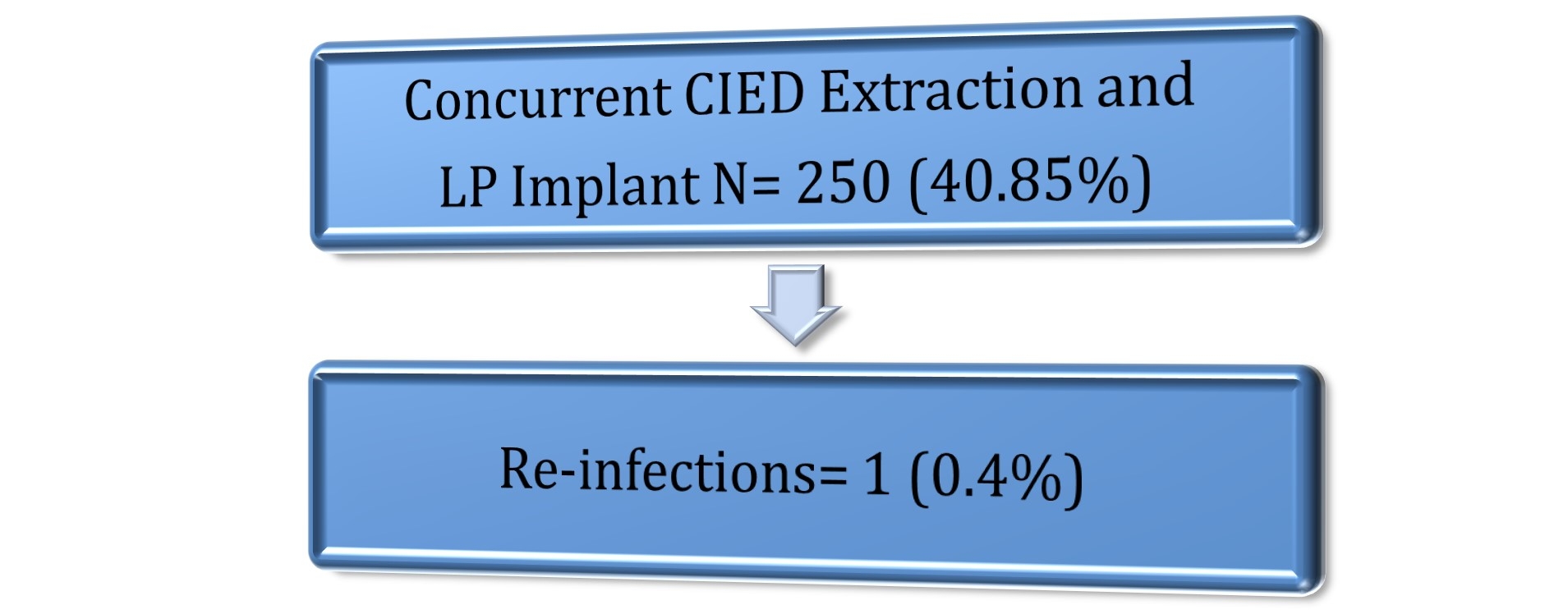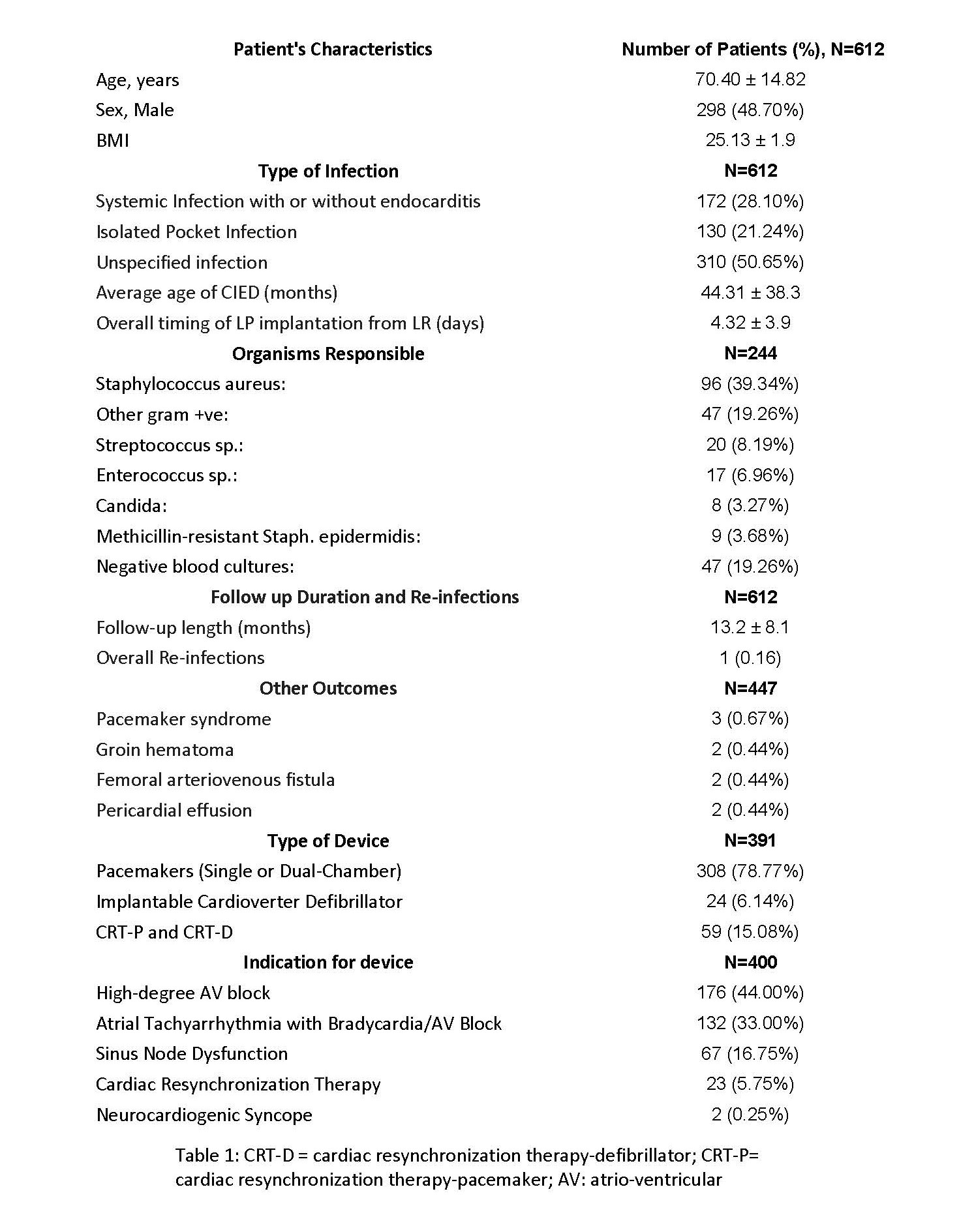Final ID: MDP1770
From Infection to Innovation: Leadless Pacemakers Implantation Following Infected Cardiovascular Implantable Electronic Device Extraction - An Updated Systematic Review
Abstract Body (Do not enter title and authors here): Introduction:
Cardiovascular Implantable Electronic Device (CIED) infection is class I indication for complete transvenous lead removal (LR). The reimplantation strategies post-LR, especially in pacemaker-dependent patients or those necessitating cardiac resynchronization therapy (CRT) and/or implantable defibrillators, remain complex. Considering the limitations and risks associated with traditional approaches, the exploration of alternative devices such as leadless pacemakers (LP) have garnered attention due to their purported lower infection risk.
Methods:
We meticulously reviewed literature sources including PubMed, Scopus, and Embase utilizing a combination of search terms. The inclusion criterion was LP implantation post-LR of infected CIED, while the exclusion criterion was LR for noninfectious indications. Study endpoints encompassed patients’ outcomes during follow-up.
Results:
Our literature review yielded 818 articles, of which 21 met the inclusion criteria, encompassing a cohort of 612 patients who underwent LR followed by LP implantation (Table 1). A total of 250 (40.8%) patients underwent concurrent LP implantation during the LR procedure. The rest underwent staged procedures and the overall duration between LR of infected CIED and LP implantation was 4.32 ± 3.9 days. In our cohort, 172 (28.1%) patients had systemic CIED infections, whereas 130 (21.2%) had isolated pocket infections, with Staphylococcus aureus as the predominant causative organism in 96 (39.3%) cases. Procedural complications were scarce. Over a mean follow-up period of 13.2 ± 8.1 months, pacemaker syndrome was observed in 3 (0.67%) patients, while 1 (0.16%) patient had a re-infection related to LP.
Conclusion:
The remarkably low incidence of complications and re-infections following LP implantation underscores its potential utility as a viable implantation option after LR, particularly in pacing-dependent patients at higher risk of CIED infections.
Cardiovascular Implantable Electronic Device (CIED) infection is class I indication for complete transvenous lead removal (LR). The reimplantation strategies post-LR, especially in pacemaker-dependent patients or those necessitating cardiac resynchronization therapy (CRT) and/or implantable defibrillators, remain complex. Considering the limitations and risks associated with traditional approaches, the exploration of alternative devices such as leadless pacemakers (LP) have garnered attention due to their purported lower infection risk.
Methods:
We meticulously reviewed literature sources including PubMed, Scopus, and Embase utilizing a combination of search terms. The inclusion criterion was LP implantation post-LR of infected CIED, while the exclusion criterion was LR for noninfectious indications. Study endpoints encompassed patients’ outcomes during follow-up.
Results:
Our literature review yielded 818 articles, of which 21 met the inclusion criteria, encompassing a cohort of 612 patients who underwent LR followed by LP implantation (Table 1). A total of 250 (40.8%) patients underwent concurrent LP implantation during the LR procedure. The rest underwent staged procedures and the overall duration between LR of infected CIED and LP implantation was 4.32 ± 3.9 days. In our cohort, 172 (28.1%) patients had systemic CIED infections, whereas 130 (21.2%) had isolated pocket infections, with Staphylococcus aureus as the predominant causative organism in 96 (39.3%) cases. Procedural complications were scarce. Over a mean follow-up period of 13.2 ± 8.1 months, pacemaker syndrome was observed in 3 (0.67%) patients, while 1 (0.16%) patient had a re-infection related to LP.
Conclusion:
The remarkably low incidence of complications and re-infections following LP implantation underscores its potential utility as a viable implantation option after LR, particularly in pacing-dependent patients at higher risk of CIED infections.
More abstracts on this topic:
All-cause mortality for Patients with Preserved Ejection Fraction Heart Failure stratified by B-blocker Therapy and Presence of Permanent Pacemaker.
Leavitt Jonas, Cunn Gregory, Coleman Kristie, Ahmad Sana, Bekiaridou Alexandra, Gasparis Christopher, Fishbein Joanna, Mountantonakis Stavros
Black Patients Have Higher Odds of Discharge with Wearable Cardioverter-DefibrillatorsAntwi Amoabeng Daniel, Sado Ikpemosi, Beutler Bryce, Governor Samuel, Gbadebo T David


